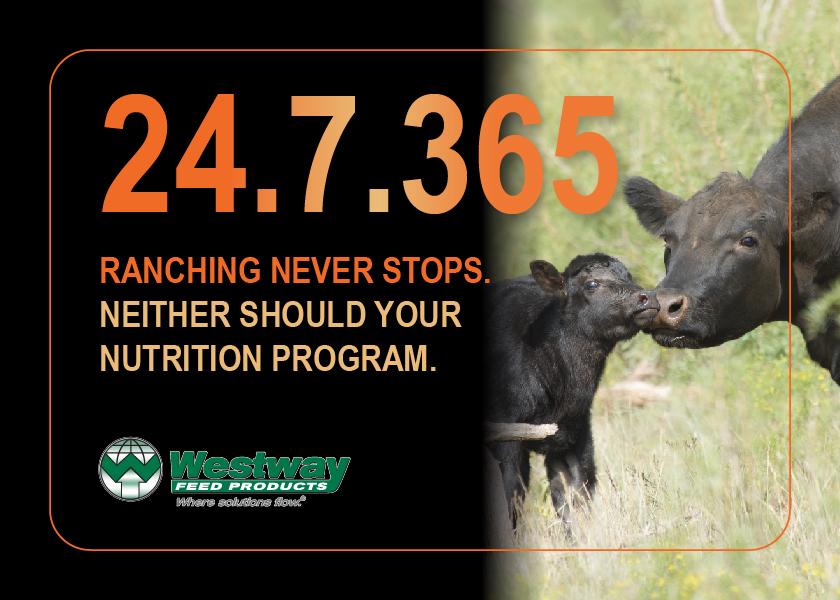What is 24 / 7 / 365 annualized nutrition?

Very simply, annualized nutrition is a systematic approach to your cowherd’s nutrition. It’s having more than just a seasonal feed program. Instead, it is providing supplementation to complement your forages, hay, or total mixed rations. By managing your cows for optimum body condition and nutrition levels throughout the year, you can gain added results in pregnancy rates, calf performance, herd health, multi-generational fertility rates and carcass values. Annualized nutrition is providing molasses-based liquid feed supplements 24 / 7 / 365... all day, every day.
Westway Feed Product’s liquid feeds offer added protein, energy, and vitamin / mineral supplementation in a convenient, minimal waste feeding method. Distributed in lick wheel tanks, the molasses-based product provides increased forage digestibility and supports rumen microbe population growth / improvement. In turn, cattle better utilize forages in all forms.
The concept of annualized nutrition has been proven to enhance profitability and cattle efficiency. Annualized nutrition programs utilizing liquid feed supplement provide producers with more and heavier calves. Historical data collection on southern / southwest ranches has shown that cattle will consume similar or reduce supplement intake by 20% with consistent performance over the years. It has been illustrated that cattle can rebreed each year at approximately 95% or better and increase weaning weight by 60-90 pounds per weaned calf.
Reproduction (number of calves) and pounds of weaned calves drive profitability for cattle operations. Stan Bevers (Ranch consultant and faculty member at the King Ranch Institute) evaluated 31 cow herds across the United State that average 1,624 head. His research found that the average pregnancy rate was 90%, a calving rate of 82.7% and a weaning rate of 80.2%. These numbers dramatically affect the breakeven for the ranch with only 80% of the cows supporting the bottom-line. Bevers also found that weaning weights average 561 pounds and average value was$161.04/cwt with a breakeven cost of $207.81 (Gulf Coast Cattleman January 2021 page 44 & 46). The cows that did not wean a calf cost the ranch $178.88/ hd. On average the ranch lost $262.38 per calf. It stands to reason that an opportunity to increase the reproduction efficiency of cattle should enhance the profitability of an operation.
A systematic / annualized nutrition program also supports more efficient feed delivery versus conventional dry feed delivery. On large cattle operations it is not uncommon to deliver feed each day in order to provide feed supplement (such as cubes) for all the cattle. Liquid feed supplementation can generally be delivered less frequently based on the size of each operation. To help increase pasture utilization, liquid feed tank locations can be moved to pull cattle to less used areas of a pasture. This promotes better grazing distribution across pastures.
Next, an annualized nutrition program also provides support for the social sustainability goals of the beef cattle industry. Cattle consistently stay in better body condition throughout the year. This supports better animal husbandry and offers to build trust from consumers that cattleman manage and care for their cattle to the highest degree possible.
The bottom line is that when cattle producers provide optimum supplementation to complement their forages, they can see increased economic returns. Providing the right nutrition to your cowherd 24 / 7 / 365 can offer better cow body condition scores. In turn, more cows breed sooner, and the result is more pounds weaned. Long term, annualized nutrition also supports fetal programming in all trimesters of a cow’s pregnancy. This results in multigenerational increases in reproductive efficiency, feedlot, and carcass performance.
At Westway Feed Products we know ranching never stops! Your cowherd’s nutrition requirements change with production status and are affected by seasonal forage changes. Our liquid feed products offer consistent, year-round nutrition to meet these nutritional needs and increase your opportunity for increased economic return.







